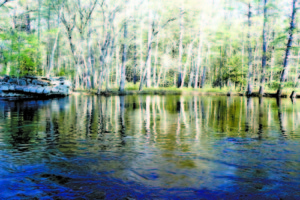Earth Notes: Quiet paddling in western Maine
My all-time favorite mode of transportation is by canoe. This ancient way of travel leaves me feeling peaceful and present in no time as I leave work-a-day details behind with a few short paddle strokes. Experiencing the floating support, being suspended on water, another body holding me up and carrying me along, is powerful and healing. The sound of the wooden paddle slicing through the water's surface, plunging down silently, propelling me along the slowly passing scenery, the perspective gained from being on top of the water, a place no one has walked or driven before — it's simply magical.
Abenaki Indians, “The People of the Dawn,†relied a great deal on waterways in this area for easy and swift transport. Maine has seven major rivers that tribes used as super highways to explore, gather resources, trade, and enjoy the bounty provided by Maine's abundant natural resources. The rivers served as trade routes and also helped the Abenaki make seasonal migrations from south to north to help ensure greater success with hunting and gathering. Many tribes spent their summers on the coast taking in the ocean's bounty. In early fall, they would paddle and pole back upstream to their winter home, rich in game, shelter, and other resources.
I get to live near the serpentine shores of the Saco River, one of these seven aquatic gems. The Saco begins in Crawford Notch, N.H. as Saco Lake, descending out of the White Mountains, traversing through 24 towns, and carving its way through southwestern Maine all the way to the Atlantic between the towns of Biddeford and Saco.
Our cities and towns used to turn their backs on the rivers, using them a receptacles for industrial waste from paper, tanning, and textile factories. Thankfully, the waterfronts are now being cleaned up, honored, and featured as the beautiful resources that they are.
The Saco has been a hotbed for conservation, drawing in the Nature Conservancy and the Saco River Corridor Commission to protect is shores and waters. Because of its seasonal flooding and extreme water level fluctuations after sudden storms, the Saco is home to rare plants and animals that grow and thrive in these varying conditions. The receding glacier left the river with a thick sandy bed that acts as a water filtration system, providing some of the cleanest water on the planet. Over 250,000 people and a number of bulk water extraction corporations tap into the aquifer beneath the Saco's sandy foundations.
The quiet paddler has an opportunity to drift across some amazing wildlife along the Saco and its connecting streams, bogs, ponds, and lakes. I have been directly escorted by a river otter and thwacked into attention by beavers adamantly slapping their tails to let me know who's turf I’m in. I have paused to watch dozens of painted turtles sunbathe on a river-worn log, and around a bend and curve, I followed a kingfisher’s distinct flight and song. I have been mesmerized by the stillness of a great blue heron, and humbled and inspired by the majesty of bald eagles and ospreys.
Magic happens when one just shows up and joins the circle of what is already going on, tuning into the rhythm of the natural world. Canoeing offers a lifelong opportunity to access the wilderness we still get to experience and witness. Paddling totally shifts my mental state. There is still deep quiet in western Maine, away from the hubbub of major highways, out of town just enough to smell the trees, see the sky, and hear the birdsong strong.
Jen Deraspe, founder of Nurture Through Nature Retreat Center, Maine's first Green-Certified lodging retreat, lives off the grid on the slopes of Pleasant Mountain in Denmark. Her passion is leading earth-friendly retreats and holistic life coaching. For more information about her work go to www.ntnretreats.com


